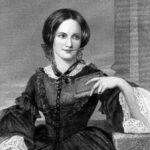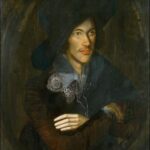There’s a certain slant of light,
On winter afternoons,
That oppresses, like the weight
Of cathedral tunes.
Heavenly hurt it gives us;
We can find no scar,
But internal difference
Where the meanings are
Emily Dickinson is known as a very private and prolific American poet, who penned almost 2000 verses. Her work was intensely private and just as intensely powerful. Her wrote of death, pain, and loneliness in a style that was brief and intellectual. For these reasons, she has become one of the most celebrated American poets of the nineteenth century.
Her life and Her Work
Emily Dickinson was born on December 10, 1830 in Amherst, Massachusetts. Her family was prominent and had arrived in America as part of the Puritan emigration two centuries earlier. Her grandfather founded Amherst College and her father was a lawyer and Congressman. Her mother, deeply religious, was distant and not nurturing. Dickinson began her education at Amherst Academy and completed her education at the Mount Holyoke Female Seminary in 1848.
By the age of 20, Dickinson began writing verse. Her first published verse appeared in the Springfield Daily Republican in 1852. It read –
Awake ye muses nine
sing me a strain divine
Unwind the solemn twine
and tie my Valentine.
A few of Dickinson’s poems appeared in Samuel Bowles’ Springfield Republican between 1858 and 1868. They were published anonymously and unfortunately were heavily edited, with conventionalized punctuation and formal titles. These poems included A Narrow Fellow in the Grass (The Snake), Safe in their Alabaster Chambers (The Sleeping) and “Blazing in the Gold and Quenching in Purple (Sunset.)
Dickinson was eccentric to the point of being referred to the nun of Amherst. Her life had been traumatized by the deaths of those close to her. Her contact with the outside world was limited and she maintained most friendships through correspondence.
She read the works of John Keats, Sir Thomas Browne, Henry Wordsworth Longfellow, and Shakespeare as well as female writers Elizabeth Barrett Browning, George Elliott and Charlotte and Emily Bronte.
As her personal life continued to be tragic, she continued her self imposed exile and her craft. She published six of her mass of 1800 poems during her life, but did not feel encouraged by her friends or her own personal desire for privacy to publish extensively.
Because I could not stop for Death
He kindly stopped for me
The Carriage held but just ourselves
And Immortality.
We slowly drove, he knew no haste
And I had put away
My labor and my leisure too,
For his civility.
On May 15, 1886, Dickinson died from complications from Bight’s disease. Her bequest included instructions on destroying her letters, but this is how her family found the volumes and volumes of her prose
Her Influence
Dickinson’s influence is multifaceted. Her poetry reflected her own personal sorrows and loneliness, but also offered a new style of writing. She used brevity and imagery well. She used her verse to reflect a reverence for the world, but also as a means of explaining necessary human truths such as faith, life, death and God.
I’m nobody! Who are you?
Are you nobody, too?
Then there’s a pair of us — don’t tell!
They’d banish us, you know.
How public like a frog
To tell your name the livelong day
To an admiring bog
How dreary to be somebody!
Dickinson’s works also has continued to influence modern poetry, because her style of writing was unconventional for her time. She used dashes, off rhymes and sporadic capitalizations for emphasis. Her work inspired others to look beyond stylistic conformity and is considered one of the founders of a uniquely American poetic voice.
For more information on Emily Dickinson, a copy of his collective works, including The Complete Works of Emily Dickinson, can be found in local libraries, online book dealers and bookstores. The web also offers some useful resources about his life and work. Check out the following:
http://www.kirjasto.sci.fi/emilydic.htm
http://www.vcu.edu/engweb/transcendentalism/roots/legacy/dickinson/index.html
http://en.wikipedia.org/wiki/Emily_Dickinson






